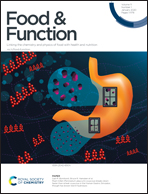Soyasaponins A1 and A2 exert anti-atherosclerotic functionalities by decreasing hypercholesterolemia and inflammation in high fat diet (HFD)-fed ApoE−/− mice
Abstract
Atherosclerosis is a chronic inflammatory disease causing coronary heart attacks and strokes. Soyasaponins (SS), the phytochemicals naturally existing in soybeans and their products, have been shown to reduce hypercholesterolemia and inflammation, which are intimately related to the genesis and development of atherosclerosis. However, the anti-atherosclerotic functionality of soyasaponins remains unknown. The aim of this study was to investigate the effects of the supplementation of two types of soyasaponin monomers (A1 and A2) on atherosclerotic plaque formation, serum lipid profiles, and inflammation in ApoE gene knockout (ApoE−/−) mice. Sixty 5-week-old ApoE−/− male mice were fed with a high-fat diet (HFD) and intervened by SSA1 and SSA2 (10 and 20 μmol per kg BW, respectively) or simvastatin (10 μmol per kg BW) for 24 weeks. The atherosclerotic lesions in the aorta, aortic root, and innominate artery, lipid profile and inflammatory markers in serum, and TLR4/MyD88/NF-κB signaling in arterial tissues were determined. SSA1 and SSA2 decreased the plaque ratio in the aortic root and innominate artery but not in the entire aorta. In serum, SSA1 reduced TG, TC, and LDL-C but increased HDL-C; SSA2 decreased TC, TG, and LDL-C but did not affect HDL-C. Meanwhile, SSA1 increased TG, SSA2 increased TC, and both of them increased bile acids in the feces. SSA1 and SSA2 lowered TNF-α, MCP-1, and hs-crp in serum. Furthermore, SSA1 and SSA2 reduced the TLR4 and MyD88 expressions in the aorta and innominate artery and inhibited NF-κB p65 and IκBα phosphorylation in the aorta. These results suggest that SSA1 and SSA2 exert anti-atherosclerotic functionalities by decreasing hypercholesterolemia and inflammation in HFD-fed ApoE−/− mice.

- This article is part of the themed collection: Food & Function Recent HOT articles


 Please wait while we load your content...
Please wait while we load your content...